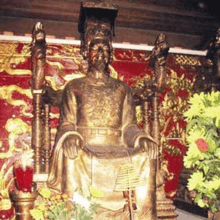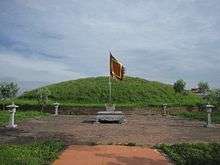Trần Thái Tông
Trần Thái Tông (birth name: Trần Cảnh, 17 July 1218 – 5 May 1277) was the first emperor of the Trần Dynasty, seated on the throne for 33 years (1226–58), being Grand Emperor for 19 years. He reigned during the first Mongol invasion of Vietnam before eventually abdicating in favor of his son Trần Thánh Tông in 1258.
| Trần Thái Tông 陳太宗 | |||||||||||||||||
|---|---|---|---|---|---|---|---|---|---|---|---|---|---|---|---|---|---|
 | |||||||||||||||||
| Emperor of Đại Việt | |||||||||||||||||
| Reign | 11 January 1226 – 30 January 1258 | ||||||||||||||||
| Predecessor | Lý Chiêu Hoàng | ||||||||||||||||
| Successor | Trần Thánh Tông | ||||||||||||||||
| Emperor of Trần dynasty | |||||||||||||||||
| Reign | 11 January 1226 – 30 January 1258 | ||||||||||||||||
| Predecessor | Dynasty established | ||||||||||||||||
| Successor | Trần Thánh Tông | ||||||||||||||||
| Retired Emperor of Trần dynasty | |||||||||||||||||
| Reign | 1258–1277 | ||||||||||||||||
| Predecessor | Trần Thừa | ||||||||||||||||
| Successor | Trần Thánh Tông | ||||||||||||||||
| Born | 17 July 1218 Hương Tức Mặc, (present-day Nam Định) | ||||||||||||||||
| Died | 5 May 1277 (aged 58) Thăng Long | ||||||||||||||||
| Burial | 31 October 1277 Chiêu Lăng | ||||||||||||||||
| Spouse | Empress Chiêu Thánh (m. 1226–1237) Empress Thuận Thiên | ||||||||||||||||
| Issue | Trần Thánh Tông Trần Ích Tắc | ||||||||||||||||
| |||||||||||||||||
| House | Trần Dynasty | ||||||||||||||||
| Father | Trần Thừa | ||||||||||||||||
| Mother | Lady Lê | ||||||||||||||||
Early life
The ancestors of the Trần clan originated from the province of Fujian before they migrated under Trần Kính (陳京, Chén Jīng) to Đại Việt.[1][2]
Trần Thái Tông's given name was "Trần Cảnh" (陳煚). He was born in 1218 during the last years of the Lý Dynasty. Trần Thủ Độ, his uncle, prepared the way for his marriage to Queen Lý Chiêu Hoàng, the last queen of the Lý Dynasty, who later abdicated to make him the founder of the Trần Dynasty in 1226.
His progress to the throne in particular and the replacement of the Trần Dynasty over the Lý Dynasty in general were mostly thanks to the efforts of Trần Thủ Độ, Trần Cảnh's uncle. At that time, Trần Thủ Độ was the front commander of citadels of the Lý Dynasty. Trần Cảnh's father, Trần Thừa, was also an official under the Lý Dynasty, like Trần Thủ Độ. He had been "Nội thị khán thủ", one of the most important officials in the Lý Dynasty.
Reign
During his reign Trần Thái Tông used three era names: Kiến Trung (1225–1232), Thiên Ứng Chính Bình (1232–1250) and Nguyên Phong (1251–1258).
In the autumn of 1257, Mongol general Uriyangkhadai addressed three letters to Trần demanding passage through to southern China in order to attack the Song dynasty.[3] After the three successive envoys were imprisoned in the capital Thang Long (modern-day Hanoi) of Dai Viet, Uriyangkhadai invaded Dai Viet.[3] A battle was fought in which the Vietnamese used war elephants: their Emperor even led his army from atop an elephant. Aju ordered his troops to fire arrows at the elephants' feet. The animals turned in panic and caused disorder in the Đại Việt army, which was routed. The Dai Viet senior leaders were able to escape on pre-prepared boats while part of their army was destroyed at No Nguyen (modern Viet Tri on the Hong River). The remainder of the Dai Viet army again suffered a major defeat in a fierce battle at the Phu Lo bridge the day after. This led the Tran leadership to evacuate the capital. The Dai Viet annals report that the evacuation was "in an orderly manner;" however this is viewed as a embellishment because the Dai Viet must have retreated in disarray to leave their weapons behind in the capital.[4] While Chinese source material incorrectly stated that Uriyangkhadai withdrew from Vietnam due to poor climate,[5][6] Uriyangkhadai left Thang Long after nine days to invade the Song dynasty.[6] After the Mongol departure, Trần agreed to send tribute every 3 years to the court of the Mongol Empire.
Learned in both Confucianism and Buddhism, he ruled the country wisely and authored several profound works on Buddhism, the most famous of which is Khoa Hu Luc (Instructions on Emptiness), a Zen manual. A prodigious writer, he left behind a substantial number of works, of which only a small number survive.
A boy student was given money in exchange for becoming a eunuch by Tran Canh in 1254 since many men castrated themselves to become eunuchs during the Tran and Ly dynasties.[7]
In 1258 he abdicated the throne in favor of his son, crown prince Trần Hoảng.
Family
There is nothing that gives reference to exactly how many children he had, but it is known that he had children by the name of Trần Trịnh[8] (died prematurely), Tĩnh Quốc Vương Trần Quốc Khang,[9] Trần Hoảng, Chiêu Minh Vương Trần Quang Khải, Trần Nhật Vĩnh, Chiêu Quốc Vương Trần Ích Tắc, Chiêu Văn Vương Trần Nhật Duật, Chiêu Đạo Vương Trần Quang Xưởng, princesses Thiên Thành (wife of Hưng đạo Vương Trần Quốc Tuấn), Thiều Dương, Thuỵ Bảo, An Tư.

- Father: Trần Thái Tổ
- Mother: Lady Lê thị
- Brother(s) and sister(s):
- Older brother: King of Yên Sinh
- Older sister: Princess Thụy Bà, adoptive mother of Great King of Hưng Đạo
- Younger brother: King of Khâm Thiên
- Younger brother: King of Hoài Đức
- Consort(s) and their Issue(s):
- Empress Consort Chiêu Thánh
- Crown Prince Trần Trịnh
- Empress Consort Thuận Thiên
- Prince Trần Quốc Khang, later King of Tĩnh Quốc
- Crown Prince Trần Hoảng, later Emperor Trần Thánh Tông
- Prince Trần Quang Khải, later Great King of Chiêu Minh
- Other Issues:
- Prince Trần Nhật Vĩnh, King of Bình Nguyên
- Prince Trần Duy, King of Vũ Uy
- Prince Trần Quang Xưởng, King of Chiêu Đạo
- Prince Trần Ích Tắc, King of Chiêu Quốc
- Prince Trần Nhật Duật, King of Chiêu Văn
- Prince Trần Uất, King of Minh Hiến
- Princess Thiên Thành, later Queen Nguyên Từ of Great King of Hưng Đạo
- Princess Thiều Dương
- Princess Thụy Bảo, later wife of General Trần Bình Trọng
- Princess An Tư, later wife of Prince Toghan of Yuan dynasty. Prince Toghan was the ninth son of Kublai Khan.
Relation with Trần Liễu
Trần Liễu was Trần Thái Tông's elder brother. In 1237, Trần Thái Tông and Empress Chiêu Thành still did not have any son to maintain the continuation of his dynasty, due to Trần Trịnh's premature death.
At that time, Princess Thuận Thiên, Trần Liễu's wife, had been pregnant with Quốc Khang for 3 months. Trần Thủ Độ and his wife princess Thiên Cực advised the emperor to arrogate the pregnancy to himself to maintain the continuity of the dynasty. Taking their advice, the emperor gave injunction to appoint princess Thuận Thiên the status of empress, and demote Chiêu Hoàng to princess. In response, Trần Liễu took his army to Cai River to rebel.
This incident embarrassed Trần Thái Tông and he left the capital for Yên Tử mountain. Only after taking advice from the Buddhist priests Trần Thủ Độ and Phù Vân, did he return to the capital. Two weeks later, Trần Liễu surrendered. Trần Thủ Độ intended to behead him, but Trần Thái Tông intervened by covering him with his body, so that Trần Thủ Độ could not do anything. Afterwards, he gave him his territory, consisting of Yên Phụ, Yên Dưỡng, Yên Sinh, Yên Hưng, and Yên Bang.
Due to the name of his territory, Liễu is also called "Yên Sinh Vương."
Notes
- "Ham sắc, Tô Trung Từ tự hại mình". Retrieved 3 September 2017.
- "Nhà Trần khởi nghiệp". Retrieved 3 September 2017.
- Lien, Vu Hong; Sharrock, Peter (2014). "The First Mongol Invasion (1257–8 CE)". Descending Dragon, Rising Tiger: A History of Vietnam. Reaktion Books. ISBN 978-1780233888.
- Descending Dragon, Rising Tiger: A History of Vietnam by Vu Hong Lien, Peter Sharrock, Chapter 6.
- Buell, P.D. "Mongols in Vietnam: end of one era, beginning of another". First Congress of the Asian Association of World Historians 29–31 May 2009 Osaka University Nakanoshima-Center.
- Haw, Stephen G. (2013). "The deaths of two Khaghans: a comparison of events in 1242 and 1260". Bulletin of the School of Oriental and African Studies, University of London. 76 (3): 361–371. doi:10.1017/S0041977X13000475. JSTOR 24692275.
- K. W. Taylor (9 May 2013). A History of the Vietnamese. Cambridge University Press. pp. 121–. ISBN 978-0-521-87586-8.
- from Đại Việt Sử Ký Toàn Thư
- de facto the offspring of Trần Liễu and Princess Thuận Thiên
References
- Ngô Sĩ Liên (1993), Đại Việt sử ký toàn thư (in Vietnamese) (Nội các quan bản ed.), Hanoi: Social Science Publishing HouseCS1 maint: ref=harv (link)
Trần Thái Tông Born: 1218 Died: 1277 | ||
| Regnal titles | ||
|---|---|---|
| Preceded by Lý Chiêu Hoàng as Empress of Lý dynasty |
Emperor of Trần dynasty 1226–1258 |
Succeeded by Trần Thánh Tông |
| Preceded by Trần Thừa |
Retired Emperor of Trần dynasty 1258–1277 |
Succeeded by Trần Thánh Tông |
| Lý royal family (notable members) | |||||||||||||||||||||||||||||||||||||||||||||||||||||||||||||||||||||||||||||||||||||||||||||||||||||||||||||||||||||||||||||||||||||||||||||||||||||||||||||||||||||||||||||||||||||||||||||||||||||||||||||||||||||||||||||||||||||||||||||||||||||||||||||||||||||||||||||||||||||||||||||||||||||||||||||||||||||||||||||||||||||||||||||||||||||||||||||||||||||||||||||||||||||||||||||||||||||||||||||||||||||||||||||||||||||||||||||||||||||||||||||||||||||||||||||||||||||||||||||||||||||||||||||||||||||||||||||||||||||||||||||||||||||||||||||||||||||||||||||||||||||||||||||||||||||||||||||||||||||||||||||||||||||||||||||||||||||||||||||||||||||||||||||||||||||||||||||||||||||||||||||||||||||||||||||||||||||||||||||||||||||||||||||||||||||||||||||||||||||||||||||||||||||||||||||||||||||||||||||||||||||||||||||||||||||||||||||||||||||||||||||||||||||||||||||||||||||||||||||||||||||||||||||||||||||||||||||||||||||||||||||||||||||||||||||||||||||||||||||||||||||||||||||||||||||||||||||||||||||||
|---|---|---|---|---|---|---|---|---|---|---|---|---|---|---|---|---|---|---|---|---|---|---|---|---|---|---|---|---|---|---|---|---|---|---|---|---|---|---|---|---|---|---|---|---|---|---|---|---|---|---|---|---|---|---|---|---|---|---|---|---|---|---|---|---|---|---|---|---|---|---|---|---|---|---|---|---|---|---|---|---|---|---|---|---|---|---|---|---|---|---|---|---|---|---|---|---|---|---|---|---|---|---|---|---|---|---|---|---|---|---|---|---|---|---|---|---|---|---|---|---|---|---|---|---|---|---|---|---|---|---|---|---|---|---|---|---|---|---|---|---|---|---|---|---|---|---|---|---|---|---|---|---|---|---|---|---|---|---|---|---|---|---|---|---|---|---|---|---|---|---|---|---|---|---|---|---|---|---|---|---|---|---|---|---|---|---|---|---|---|---|---|---|---|---|---|---|---|---|---|---|---|---|---|---|---|---|---|---|---|---|---|---|---|---|---|---|---|---|---|---|---|---|---|---|---|---|---|---|---|---|---|---|---|---|---|---|---|---|---|---|---|---|---|---|---|---|---|---|---|---|---|---|---|---|---|---|---|---|---|---|---|---|---|---|---|---|---|---|---|---|---|---|---|---|---|---|---|---|---|---|---|---|---|---|---|---|---|---|---|---|---|---|---|---|---|---|---|---|---|---|---|---|---|---|---|---|---|---|---|---|---|---|---|---|---|---|---|---|---|---|---|---|---|---|---|---|---|---|---|---|---|---|---|---|---|---|---|---|---|---|---|---|---|---|---|---|---|---|---|---|---|---|---|---|---|---|---|---|---|---|---|---|---|---|---|---|---|---|---|---|---|---|---|---|---|---|---|---|---|---|---|---|---|---|---|---|---|---|---|---|---|---|---|---|---|---|---|---|---|---|---|---|---|---|---|---|---|---|---|---|---|---|---|---|---|---|---|---|---|---|---|---|---|---|---|---|---|---|---|---|---|---|---|---|---|---|---|---|---|---|---|---|---|---|---|---|---|---|---|---|---|---|---|---|---|---|---|---|---|---|---|---|---|---|---|---|---|---|---|---|---|---|---|---|---|---|---|---|---|---|---|---|---|---|---|---|---|---|---|---|---|---|---|---|---|---|---|---|---|---|---|---|---|---|---|---|---|---|---|---|---|---|---|---|---|---|---|---|---|---|---|---|---|---|---|---|---|---|---|---|---|---|---|---|---|---|---|---|---|---|---|---|---|---|---|---|---|---|---|---|---|---|---|---|---|---|---|---|---|---|---|---|---|---|---|---|---|---|---|---|---|---|---|---|---|---|---|---|---|---|---|---|---|---|---|---|---|---|---|---|---|---|---|---|---|---|---|---|---|---|---|---|---|---|---|---|---|---|---|---|---|---|---|---|---|---|---|---|---|---|---|---|---|---|---|---|---|---|---|---|---|---|---|---|---|---|---|---|---|---|---|---|---|---|---|---|---|---|---|---|---|---|---|---|---|---|---|---|---|---|---|---|---|---|---|---|---|---|---|---|---|---|---|---|---|---|---|---|---|---|---|---|---|---|---|---|---|---|---|---|---|---|---|---|---|---|---|---|---|---|---|---|---|---|---|---|---|---|---|---|---|---|---|---|---|---|---|---|---|---|---|---|---|---|---|---|---|---|---|---|---|---|---|---|---|---|---|---|---|---|---|---|---|---|---|---|---|---|---|---|---|---|---|---|---|---|---|---|---|---|---|---|---|---|---|---|---|---|---|---|---|---|---|---|---|---|---|---|---|---|---|---|---|---|---|---|---|---|---|---|---|---|---|---|---|---|---|---|---|---|---|---|---|---|---|---|---|---|---|---|---|---|---|---|---|---|---|---|---|---|---|---|---|---|---|---|---|---|---|---|---|---|---|---|---|---|---|---|---|---|---|---|---|---|---|---|---|---|---|---|---|---|---|---|---|---|---|---|---|---|---|---|---|---|---|---|---|---|---|---|---|---|---|---|---|---|---|---|---|---|---|---|---|---|---|---|---|---|---|---|---|---|---|---|---|---|---|---|---|---|---|---|---|---|---|---|---|---|---|---|---|---|---|---|---|---|---|---|---|---|---|---|---|---|---|---|---|---|---|---|---|---|---|---|---|---|---|---|---|---|---|---|---|---|---|---|---|---|---|---|---|---|---|---|---|---|---|---|---|---|---|---|---|---|---|---|---|---|---|---|---|---|---|---|---|---|---|---|---|---|---|---|---|---|---|---|---|---|---|---|---|---|---|---|---|---|---|---|---|
| |||||||||||||||||||||||||||||||||||||||||||||||||||||||||||||||||||||||||||||||||||||||||||||||||||||||||||||||||||||||||||||||||||||||||||||||||||||||||||||||||||||||||||||||||||||||||||||||||||||||||||||||||||||||||||||||||||||||||||||||||||||||||||||||||||||||||||||||||||||||||||||||||||||||||||||||||||||||||||||||||||||||||||||||||||||||||||||||||||||||||||||||||||||||||||||||||||||||||||||||||||||||||||||||||||||||||||||||||||||||||||||||||||||||||||||||||||||||||||||||||||||||||||||||||||||||||||||||||||||||||||||||||||||||||||||||||||||||||||||||||||||||||||||||||||||||||||||||||||||||||||||||||||||||||||||||||||||||||||||||||||||||||||||||||||||||||||||||||||||||||||||||||||||||||||||||||||||||||||||||||||||||||||||||||||||||||||||||||||||||||||||||||||||||||||||||||||||||||||||||||||||||||||||||||||||||||||||||||||||||||||||||||||||||||||||||||||||||||||||||||||||||||||||||||||||||||||||||||||||||||||||||||||||||||||||||||||||||||||||||||||||||||||||||||||||||||||||||||||||||
Notes:
| |||||||||||||||||||||||||||||||||||||||||||||||||||||||||||||||||||||||||||||||||||||||||||||||||||||||||||||||||||||||||||||||||||||||||||||||||||||||||||||||||||||||||||||||||||||||||||||||||||||||||||||||||||||||||||||||||||||||||||||||||||||||||||||||||||||||||||||||||||||||||||||||||||||||||||||||||||||||||||||||||||||||||||||||||||||||||||||||||||||||||||||||||||||||||||||||||||||||||||||||||||||||||||||||||||||||||||||||||||||||||||||||||||||||||||||||||||||||||||||||||||||||||||||||||||||||||||||||||||||||||||||||||||||||||||||||||||||||||||||||||||||||||||||||||||||||||||||||||||||||||||||||||||||||||||||||||||||||||||||||||||||||||||||||||||||||||||||||||||||||||||||||||||||||||||||||||||||||||||||||||||||||||||||||||||||||||||||||||||||||||||||||||||||||||||||||||||||||||||||||||||||||||||||||||||||||||||||||||||||||||||||||||||||||||||||||||||||||||||||||||||||||||||||||||||||||||||||||||||||||||||||||||||||||||||||||||||||||||||||||||||||||||||||||||||||||||||||||||||||||